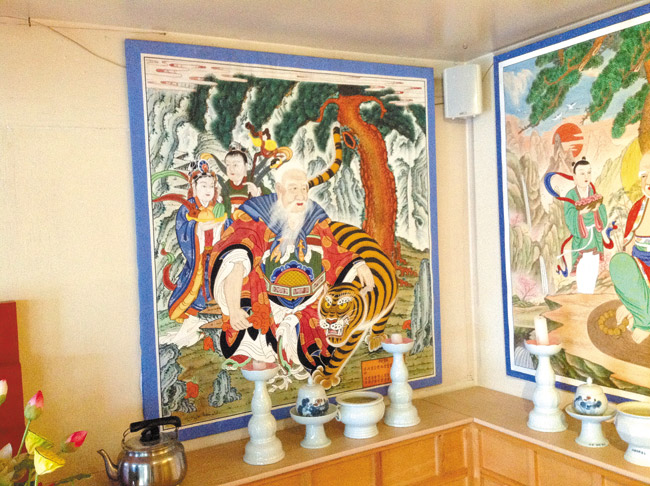Buddhism Morphed By Migration
When our daughter was only a few months old, my wife and I took her grocery shopping in Hawaii Kai. We were new parents proudly walking down the aisles when a woman stopped us to compliment us on our daughter. “My, what a lovely baby. What race is she?” I proudly replied, “Well, I’m Japanese, and my wife is Chinese.” “Oh, so she’s Korean?” the woman laughed and walked away, pleased with herself.
It is difficult to tell Chinese, Koreans and Japanese apart. To many people, they all look the same. For Chinese, Korean and Japanese Buddhists, however, this is certainly not the case. As Buddhism spread from its origins in India to China, Korea and Japan, it adapted to and blended with the native religious traditions of each culture, resulting in very distinctive forms of Buddhism.
mw-sakashita-080614-sanshin-painting
There are thus recognizable traits and characteristics at Chinese, Korean and Japanese Buddhist temples that distinguish one from the other. Here’s a brief guide for helping visitors to local Buddhist temples discern which is which:
Chinese temples
The Confucian emphasis on ancestor veneration and Daoist influence are prominent at local Chinese Buddhist temples. Before even entering the temple grounds, one notices Chinese temples often are painted in colors representing the five elements: red, yellow, green, black and white. The colors symbolize certain values, including balance, harmony and prosperity. Inside the temple gate area, but just outside the entrance of the temple itself, one will often see followers burning paper offerings in the form of spirit money, clothes, houses and other goods, and sending these to the ancestors. The offerings are a way to maintain relationships with the deceased. Within the temples, there are cushions on the ground for followers to kneel on when praying and consulting the gods. One will also see followers pull sticks of bamboo from a canister, then throw red moon blocks on the floor to divine guidance from the gods.
These traits and practices are not found at Korean or Japanese temples.
Korean temples
It is easy to recognize Korean Buddhist temples by distinct and traditional decorative coloring known as dancheong. Dancheong (literally “red-blue”) is painted onto the eaves of the temple’s roof and is distinguished by its fascinating patterns of animals (dragons, lions, cranes), flowers, and geometric designs. Dancheong enhances the spiritual quality of the temple and some believe it protects the temple and its followers. The eaves of Chinese and Japanese temples, by contrast, are plain.
Most Korean Buddhist temples also will have a shrine in the temple dedicated to the spirit of the mountain deity (sanshin-gak), though sometimes the deity (usually depicted as an old man accompanied by a tiger) is venerated in a painting within one of the main worship halls.
Mu Ryang-sa is the largest Korean Buddhist temple on Oahu. I was told repeatedly during several visits that san-shin-gak was a form of folk superstition, thus the practice was not observed at Mu Ryang-sa. I was ready to give up the idea that sanshin-gak was an integral part of Korean Buddhism when a woman at the temple whispered to me: “I’ll show you sanshin-gak.” She led me to a worship hall and showed me a painting with numerous mythical figures. “See sanshin?” I didn’t. “Look carefully at the top, left side.” There was a picture of Pele, the local mountain deity. Mu Ryang-sa is a traditional Korean temple after all.
Japanese temples
When Buddhism arrived in Japan in 538 CE, it interacted with the native religious tradition — Shinto — and each influenced the other. Among the several values and themes present in Shinto, its emphasis on purity and nature is most prominent at Japanese Buddhist temples. Japanese Buddhist temples tend not to be as richly painted or decorated as their Chinese and Korean counterparts. Indeed, it is common in Japan for the temples to be plain colored or the wood left in its natural state.
Another distinctive feature of Japanese religion is the practice of physically and spiritually cleansing oneself before entering the temple. A wash-basin is commonly found outside temples and shrines for followers to wash their hands and rinse their mouths. The emphasis on purity extends to inside the temple, where the floor, walls and altar area are immaculately cleaned. This is in stark contrast to Chinese Buddhist temples, where dust and incense ashes are scattered about. For Japanese Buddhists, this is unacceptable and a sign of disrespect. For Chinese Buddhists, the dust and ash symbolize the presence of the power of the Buddhas.
All of these individual traits encompass the values that characterize Chinese, Korean and Japanese cultures and distinguish one Buddhist temple from another. The gods and Buddhas know not all Asians are alike, even if some people don’t.
misfitspirit808@gmail.com






